|
|||||
FlyingRC.net is a
Veteran-Owned site.

Top-Flite Giant Scale P47 Razorback – Maiden Day 2
Finding the edges of an already great flight envelope
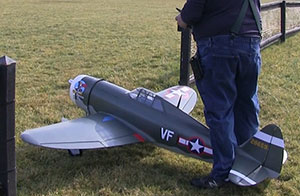 |
| Very often problems with a plane will appear during the maiden process. I would come up against a potentially destructive problem before this day ended. See it in the video below. Click Here to enlarge images. |
Text photos and video by Tom Hintz
Flight video by Mike Basmajian and Clark Ponthier
Posted – 3-14-2016
The second day of Maidening the Top-Flite Giant Scale P47 Razorback lasted about twenty feet when the right wheel came off and the retract was pulled from the wing. You can see the full story on that crash/repair by Clicking Here.
With the retract damage repaired I got back to tweaking the Top-Flite Giant Scale P47 Razorback. We use these early flights to dial the plane in so it flies correctly and predictably. One of the first things I work on is getting the trim tabs back in the center using the mechanical linkage adjustments and perhaps small changes in the radio itself using the sub trim and travel adjustments. This will be an ongoing process until I get comfortable with the plane in normal conditions.
New CG
 |
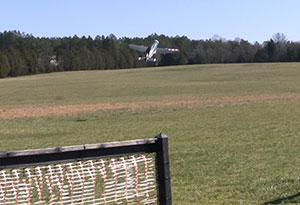 |
| The EME60 hauls this 21-lb plane around easily (let) but more aggressive take offs (right) are possible if you like. Click images to enlarge |
|
Since the first day of maiden flights I have removed 3 ounces of lead that had been mounted on the top of the motor box to correct the CG as indicated by the plane during the first test flights. I get the plane flying straight and level at about ¾ throttle then put the plane on an inverted, 45-degree up line. The Top-Flite Giant Scale P47 Razorback’s nose wanted to pull downward indicating a nose heavy condition. Since it had no other bad habits and there was no sensitivity at the elevator or other controls. I felt safe in removing the 3-oz strip, half of the added weight to achieve the factory CG point.
Having removed 3 ounces of lead there was a chance that the elevator could be very sensitive if the CG moved too far towards the back of the plane. But, as soon as I got the Top-Flite Giant Scale P47 Razorback in the air after the change it was clear that the controls remained responsive but not at all sensitive. I put the Top-Flite Giant Scale P47 Razorback on an inverted, 45-degree up line again and let go of the sticks. The plane went into a very gentle arc dropping the nose towards the ground but at a much slower rate than during the first days flying. I could not detect any unwanted flight characteristics so will leave the CG alone at least for the time being. As I get more familiar with the plane being set up I might make another small CG change but will always go in small steps if I make any further changes at all.
Flaps and Landing
As with most flap-equipped planes, a bit of down elevator needs to be added when the flaps are deployed to counter the tendency of the plane to balloon. Each plane is going to react a little differently to the flap deployment so this is a setting that is developed during several “maiden” flights. I like having enough down elevator so that the plane is slightly nose down when it reaches landing speeds. I like having to hold just a bit of up elevator so when the plane reaches the ground I can pull just a little more so the plane settles to the ground smoothly. Different planes will “like” different settings so make these changes in small increments to sneak up on what feels the most comfortable for you.
Rudder
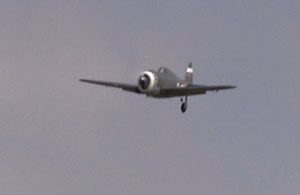 |
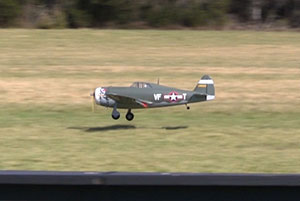 |
| ear the end of what wold be the last flight one of the retracts (left) decided o be stubborn. I eventually worked the wheel down by repeated cycling the retract switch several times but I had no idea if the retracts was locked. This had to be a "greaser" landing (right) and the Top-Flite Giant Scale P47 Razorback handling helped me a lot there. Click images to enlarge |
|
I have heard plenty of war bird/rudder stories so I have been gentle in my exploration of the Top-Flite Giant Scale P47 Razorback rudder. This kind of testing is always done up where I am confident that I can catch the plane if it should go out of control. I am happy to report that the Top-Flite Giant Scale P47 Razorback rudder is predictable and does not cause sudden snaps, rolls or stalls. I am not just jamming the rudder all the way over like I do with my 3D planes but I am not afraid to use considerable rudder in most situations.
In low speed situations such as landing I am always more careful with applying udder. Making corrections for cross winds is not hard with the Top-Flite Giant Scale P47 Razorback as long as you remain reasonable with its application. Like many planes holding a small amount of rudder will help keep the plane aligned with the runway.
During takeoff runs the Top-Flite Giant Scale P47 Razorback responds well to the rudder once the tail is up and flying. When the tail wheel is on the ground it does a good job of steering though I have the amount of steering reduced to prevent over correcting. Overall the Top-Flite Giant Scale P47 Razorback rudder is not hyper active and when used reasonably has no bad habits.
Stalls
One test all planes should be put through is intentional stalls. It is important to know what the plane is likely to do if you get too slow and the plane “falls through”. Here again I can report that the Top-Flite Giant Scale P47 Razorback is very predictable in a stall. I did several power-off stalls and it simply fell through, dropping the nose downward. You do have to give it some power to regain full control but it is not bad at all. For a warbird I think that the Top-Flite Giant Scale P47 Razorback is head and shoulders above the pack in its resistance to stalls and recovering from them.
Landings
| Video coming shortly | 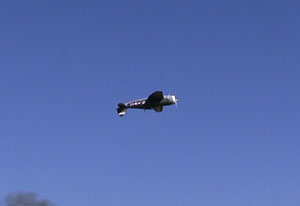 |
| Though not a 3D plane by any description the Top-Flite Giant Scale P47 Razorback is surprisingly nimble for a 21-lb warbird! Click image to enlarge |
|
Warbirds in general have a lousy reputation when it comes to landing. Here again the Top-Flite Giant Scale P47 Razorback stands out from the crowd. Its generous wing provides lots of low speed lift that keeps the plane steady at landing speeds. I always use the flaps at the recommended angle. To date there have been no surprises or near disasters during landing.
During the last “maiden” day I had a retract failure in that one side of the mains refused to come down right away. I knew I had plenty of fuel left so I worked on the problem and found that putting the retract switch in the UP position for a couple seconds and then leaving it in the down mode the offending wheel came down a little more. The Robart electric retracts have a special “amp out” motor that shuts that retract down if it encounters an obstacle so this is one area that will be investigated back in the shop.
Once I got the wheel down I had no way to know if it was actually locked so a gentle landing was mandatory. The Top-Flite Giant Scale P47 Razorback’s gentle nature on landing helped me “grease it in” and the retract stayed up. You can see this sequence in the accompanying video.
I am considering the Top-Flite Giant Scale P47 Razorback “maidened” and will now focus on getting familiar with flying it. I want to explore its limitations some but I also just want to fly it in a relatively scale manner. My trademark snap roll on takeoff just will not happen with a Top-Flite Giant Scale P47 Razorback but I expect that it will do some things that we are accustomed to seeing from a plane like this.
If you have been shying away from a warbird because of their ill-handling reputations take a hard look at the Top-Flite Giant Scale P47 Razorback. These folks have this warbird figured out and that translates to an easy flying plane that anyone with solid moderate flying skills can learn to fly, perhaps with some help along the way just to be safe.
See the previous Top-Flite Giant Scale P47 Razorback build and maiden stories
Segment #1 – Segment #2 – Segment #3 – Segment #4 – Maiden #1 - Maiden Final
See the Top-Flite Giant Scale P47 Razorback product page – Click Here
Have a comment on this Review? –Email Me!
All Flyingrc.net written, photographic and drawn materials are property of and copyright by Tom Hintz and Flyingrc.net 2013-2020 Materials cannot be used in any way without the prior written permission of the owner.
Privacy Statement


